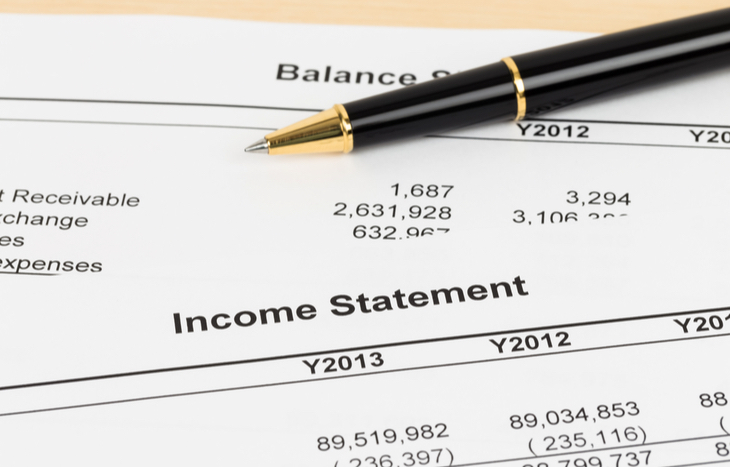What is an Income Statement?
Alongside the balance sheet and the cash flow statement, the income statement is one of the “big three” financial reporting documents every public company needs to produce each quarter. It’s a summary of a company’s performance, determined by the organization’s profitability over a period of time. It’s also known as the profit and loss (P/L) statement or the earning statement.
This document provides context for investors and stakeholders as to how efficiently the company is managing its revenues and expenses. It’s also a great evaluator for performance over time. Savvy investors can learn a lot about the management of a company, its operations and performance relative to the sector by probing the income statement.

Generally Accepted Accounting Principles (GAAP) Reporting
Like the other major financial statements, companies need to prepare their income statements according to GAAP. This means the document itself needs to meet double-entry accounting standards and GAAP standards for qualifying and contextualizing revenues, expenses and profits. Moreover, income statements need to be clear about the period they’re reporting. For example, many statements include a qualifier that says, “For the fiscal quarter ended March 30, 2021,” or similar.
In accordance with the Securities and Exchange Commission (SEC), public companies need to produce an income statement quarterly, as well as annually. Investors will find the income statement packaged within a company’s 10-K or 10-Q filing, alongside the balance sheet and the cash flow statement.
Revenues, Expenses and Profit
The income statement has three distinct sections: revenue, expenses and profit. At a glance, it tells investors everything they need to know about the company’s ability to operate at a profit (or a loss). Each section on the statement is further delineated into line items that summarize different cash flow activities.
- Revenues represent net sales and gross income, as well as miscellaneous incomes.
- Expenses show the cost of sales and selling, as well as administrative expenses.
- Profit shows the company’s gross profit, operating profit, pretax profit and net profit.
Within these sections, companies report on operating and non-operating costs. Operating revenues and expenses are those directly associated with goods or services. Conversely, non-operating revenues and expenses encompass those outside of everyday operations, such as the sale of investments.
While there are likely to be numerous line items incorporated into the revenue and expense sections, the income statement itself follows a very simple equation:
Net Income = (Total Revenue + Gains) – (Total Expenses + Losses)
Net income is the bottom-line figure that represents whether the company is operating at a profit. And while it’s an important at-a-glance metric, investors should delve into the entire income statement to understand exactly what contributes to that figure, positive or negative.
Interpreting the Income Statement
When investors look at a company’s income statement, they’re observing top- and bottom-line figures. Top line figures are those pertaining to sales and revenue; bottom line figures are those related to income. Generally, revenues are synonymous with top-line figures and expenses dictate what the bottom line shapes up to be.
Ideally, a healthy company will show consistent increases in revenues and static or falling figures in the expenses section. More sales and revenue show the company’s ability to sell more and acquire new customers, promoting top-line growth. Fewer or falling expenses indicate efficiency in operation, indicative of bottom-line savings. Investors look for both.
What happens if expenses outweigh revenues? It means the company is operating at a loss for the period reported on the income statement. This isn’t uncommon, especially for growing companies. If it persists for multiple quarters, it can be a worrying sign that eventually leads to insolvency.
In a nutshell, the more money the company brings in and the less money it needs to spend, the more profitable it is.
How to Use an Income Statement
Because income statements represent a snippet in time, they’re best-used as a representation of trends over time. For example, an investor might compare the top-line growth of a company from quarter to quarter or year over year. Or, they might look at the expenses a company incurs at a pivotal time during the year to predict future revenues in an upcoming quarter. The income statement provides a framework for comprehension in how the company operates over time.
Because income statements follow GAAP standards, they’re also useful for comparing across competitors. For example, if ABC Company has similar revenue to XYZ Company, but nearly double the expenses, it’s worth digging deeper to understand why. Is it inefficient management? Higher COGS? Digging deeper into financial reports can provide context for how a company performs relative to its peers.
Most income statements provide context, whether it’s the preceding quarter or the trailing three years. This provides quick context for the movement of the company’s revenues and expenses. Investors don’t need to hunt down the data: it’s a matter of comparing two figures side-by-side on the statement.
Pay Attention to Income Statement Trends
The most valuable part of an income statement is the accounting period it represents. While it’s nice to have a snapshot of the company’s operations, what’s even better is to see rising and falling revenue and expense data over time. If the company’s sales are on the uptrend and its expenses stay the same or get smaller, it’s a healthy sign. If top-line growth is flat and the bottom line is cumbersome, the company needs to reevaluate its operations.
Remember, the income statement is best-used alongside the balance sheet and the cash flow statement as part of a complete look at the company’s financials. Context matters—especially when you’re just looking at numbers from a specific accounting period. And this information is invaluable for investors who are preparing for retirement. To learn more, sign up for the Wealthy Retirement e-letter below!





